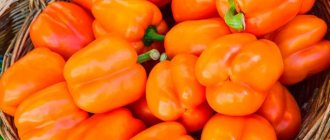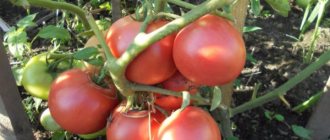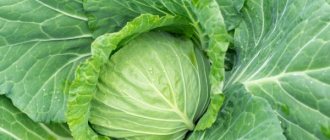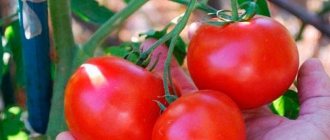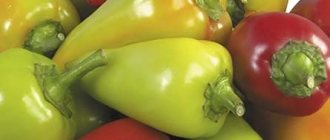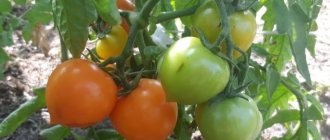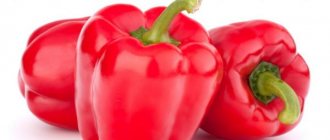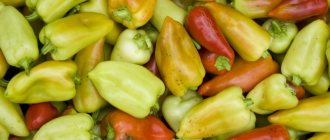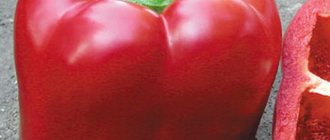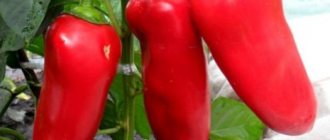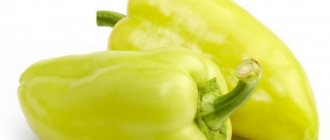Description and characteristics of the variety
Bell pepper Snow White is a reliable and productive representative of early varieties. It is cultivated in greenhouse structures (with or without heating), in greenhouses, and tunnels. Not suitable for cultivation in open beds. The first harvest is harvested 4 months after planting.
Sweet pepper Snow White grows in small compact bushes. The height of the plants does not exceed 50 cm, the stems are distinguished by their strength and abundance of ovaries and fruits.
Peppers grow up to 12 cm in length, their diameter is 9–10 cm. The shape is moderately elongated, with a triangular outline. The weight is massive - 100–150 g. The ribbing is expressed on the sides and at the stalk. The pericarp is thickened, fleshy, juicy. Wall thickness - 6–7 mm. The color is white-lime for a long time, only turning red at the very end.
The fruits of the variety are cut into salads and snacks, and first and second courses are prepared from them. Pickled peppers delight with their rich aroma and pleasant taste. They are convenient to freeze, stuff, and preserve.
Ripe peppers are well transported and stored on bushes and in refrigerated conditions. For storage, maintain the temperature at 3–6 degrees.
Snow White pepper is popular among farmers and private gardeners and is represented in the line of well-known domestic agricultural companies: Russian Garden, Gavrish, Biotekhnika, Aelita.
Pepper "Snow White": simple agricultural technology and early ripening
According to the characteristics and description of the variety, Snow White pepper is an early-ripening and reliable variety. According to gardeners, it provides stable yields, especially when grown using film covers.
This early-ripening variety has found wide application in areas with short, unpredictable summers, where the use of shelters and greenhouses has long been commonplace.
Description
This compact plant does not take up much space, the height of the bush is 45-50cm.
The leaves are light green, slightly wrinkled. The fruits are arranged droopingly, their characteristics:
- The shape is cone-shaped, length 10-11cm, diameter 5-6cm, surface smooth.
- The color at technical ripeness is light green, slightly whitish. When fully ripe, the fruits turn red.
- The walls have a thickness of 6-7mm. Pulp with excellent taste and pleasant aroma.
- Average fruit weight is 90-100g.
- Universal use - fresh, in the preparation of various culinary dishes, for canning and freezing.
Fruit ripening occurs in 100-110 days (from germination to technical ripeness). Biological ripeness occurs in another 1-2 weeks.
According to reviews, snow white sweet peppers are characterized by extended fruiting, which allows harvesting in two stages - the first harvest is with fully ripened red fruits, the second has time to ripen to technical ripeness.
Diseases and pests
The variety is relatively resistant to most pepper diseases, subject to the basic requirements of agricultural technology:
- Compliance with crop rotation (plants can be replanted in their original place or after other crops of the nightshade family, only after 3-4 years).
- Carrying out preventive spraying with copper-containing preparations or phytosporin when signs of disease occur - changes in leaf color, spotting, slow growth.
- Properly prepare the greenhouse - carry out antifungal treatment after the end of the season.
- Treat seeds with disinfectant solutions before sowing.
To combat pests of peppers - aphids, spider mites, slugs - spraying with repellent infusions of tobacco and onion peels is used. They are carried out twice, with an interval of several days.
To get rid of wireworms, which often damage the root system of peppers, deep digging and liming of the soil are used.
Why is the variety interesting?
According to reviews from gardeners, the Snow White pepper variety has come to fruition in many regions, but especially in areas with short and unpredictable summers.
Its main advantages:
- Early ripeness.
- Excellent taste.
- Stable yield.
- Versatility of use.
- Compactness of bushes.
Features of cultivation
The variety has found wide application due to simple agricultural technology and early ripening in various climatic zones. At the same time, according to reviews, the best results are obtained when using film covers.
To get an early harvest, it is important to choose the right time for sowing seeds. The optimal age for seedlings is considered to be 70-75 days, and gardeners choose the sowing time based on the climatic conditions of the area.
Since peppers love loose, nutritious soil, for seedlings it is prepared from a mixture of garden soil, humus and ash, with the addition of peat or sawdust if necessary.
Growing seedlings
Before sowing, seeds are treated with disinfectant solutions, growth stimulants and microelements.
To speed up the germination of seeds, some hobbyists place them in a moistened cloth for several days, and after the seedlings appear, they begin sowing.
Sowing is carried out in moist soil to a depth of about 1 cm, with an interval of 2-3 cm. The boxes are covered with film or glass and kept at a temperature of 23-25 degrees until germination.
The emergence of seedlings gives a signal for the seedlings to move to the brightest places - on southern window sills, under artificial lighting lamps.
When several true leaves appear, the seedlings are transplanted into larger containers - pots or cups.
Transplantation into the ground
To get an earlier harvest, summer residents try to plant peppers as early as possible - as soon as warming begins. To avoid the risk of freezing, either permanent greenhouses or temporary shelters made of arcs and film or spunbond are used.
If the shelter is temporary, the place for growing peppers should be sunny and windless; sometimes seeding of coulis (corn, sunflower) is used. The best predecessors are pumpkin plants, greens, onions, and legumes.
However, it is not recommended to bury peppers below the level at which they grew in pots.
Landing
Before sowing, the seed material is checked, soaked in warm water and any seeds that float are thrown away. To activate germination processes, they are treated with stimulants: Immunocytophyte, Epin. Leave in moistened gauze for a couple of days.
For planting, use separate containers: peat pots or cups (volume of at least 0.3 l), cassette boxes. Peppers do not like picking, which will allow you to do without the procedure. A good option is sowing in peat tablets.
The seedlings are transplanted into greenhouses when they reach 60–65 days of age. The air temperature must be at least 15 degrees, and the ground temperature at least 12 degrees.
Plants are placed on the site according to a 50 by 40 cm pattern. Per 1 sq. m of greenhouse bed, 5–6 bushes are planted.
Diseases and pests
The variety is relatively resistant to most pepper diseases, subject to the basic requirements of agricultural technology:
- Compliance with crop rotation (plants can be replanted in their original place or after other crops of the nightshade family, only after 3-4 years).
- Carrying out preventive spraying with copper-containing preparations or phytosporin when signs of disease occur - changes in leaf color, spotting, slow growth.
- Properly prepare the greenhouse - carry out antifungal treatment after the end of the season.
- Treat seeds with disinfectant solutions before sowing.
Read also: Monterey strawberries: description of the variety, planting and care, methods of propagation
To combat pests of peppers - aphids, spider mites, slugs - spraying with repellent infusions of tobacco and onion peels is used. They are carried out twice, with an interval of several days.
To get rid of wireworms, which often damage the root system of peppers, deep digging and liming of the soil are used.
Growing and care
The variety is unpretentious and responds positively to traditional agricultural practices. How to care for Snow White:
- moisturizing is carried out with a frequency of 1–2 times a week (water norm is 1–3 liters per bush);
- fertilizing is necessary once every 12–14 days;
- shaping comes down to removing the lower stepsons and shoots without productive ovaries;
- ventilate greenhouses for 15–30 minutes in the morning and evening to avoid oversaturation with moisture;
- surface treatment of beds (loosening, mulching, weeding);
- fruit rationing (pruning weak ovaries during cold weather to allow the set peppers to ripen).
For maximum yield, special attention is paid to the application of fertilizers. The first time feeding is carried out 10 days after planting the seedlings. They use a solution of urea with superphosphate, complex mixtures: Malyshok, Fertika-Lux, Agronom Profi.
During mass flowering, peppers need potassium salts. 1 tsp. potassium sulfate is dissolved in 10 liters, superphosphate is added. When ripe, the subcortex is watered once every 2 weeks. Complexes and phosphorus-potassium mixtures are suitable.
Reviews
Vladimir: “I’ve been growing peppers for a long time. Previously, I planted a crop with tall stems, but it was very difficult to care for such vegetable products. Therefore, I decided to grow this variety. It is a pleasure to care for such a crop. The main thing is to create the necessary conditions in the greenhouse. My wife really likes canning peppers like this because the vegetable size is ideal for this purpose.”
Zlata: “I used to plant hybrid varieties of crops, and they gave a good harvest. But, of course, those varieties cannot compare with the yield of “Snow White” pepper. Ripe fruits are in no way inferior in taste and quality to other elite varieties. The Snow White variety takes pride of place in the greenhouse.”
Raisa: “The Snow White variety immediately captivated me and my husband with its wonderful taste and size. The peppers ripened quickly and smoothly thanks to the fact that we regularly fed them. For feeding we used only the best mineral materials. The vegetable crop stood up well to watering once a day. The yield of this variety is so high that we shared the ripe fruits with our neighbors who did not produce fruits.”
Features of the variety
The chameleon variety “Snow White” is a variety of sweet pepper that has proven itself to be excellent. Vegetable crop belongs to the category of early ripening plants. About 100 days pass from the moment the seeds are sowed to the period when ripe peppers can be harvested.
The Snow White variety is different:
- high resistance to various diseases characteristic of nightshades;
- the formation of medium-sized bushes that grow to a maximum of 50 cm;
- Possibility of cultivation under film covers and in greenhouses.
Snow White Pepper
This vegetable has large leaves. They are distinguished by a light green tint and a slightly wrinkled structure.
Most gardeners, before planting this type of pepper, are interested in the characteristics of the fruits themselves. According to reviews from summer residents, “Snow White” pepper allows you to get very tasty, appetizing in appearance and aromatic vegetables. The fruits have a cone-shaped or triangular, somewhat elongated shape. The surface is slightly ribbed. At the top, the stalk is not sharp. It does not press into the inside of the pepper at all.
